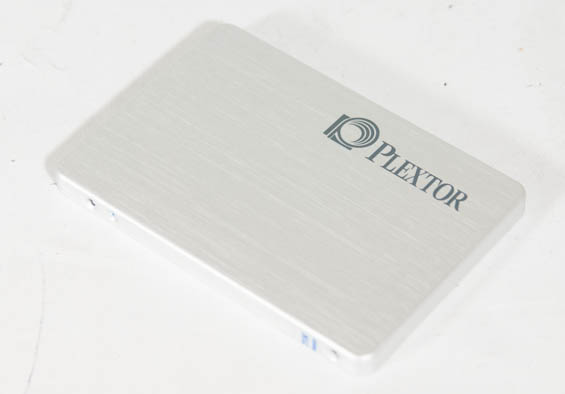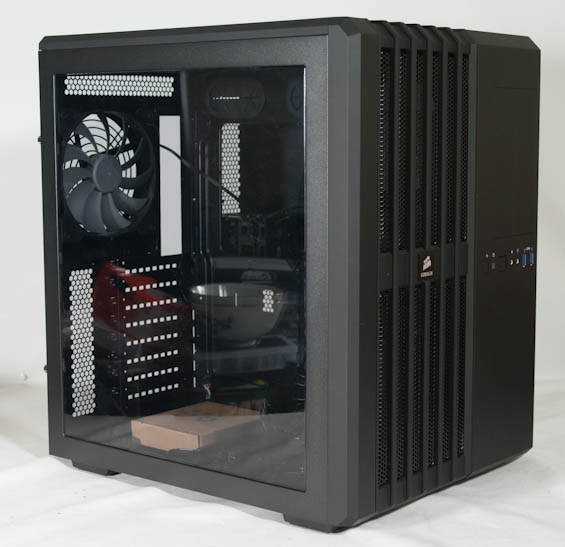The Neophyte's Custom Liquid Cooling Guide: How To, Why To, What To Expect
by Dustin Sklavos on September 30, 2013 12:01 AM ESTPlextor M5P Xtreme 256GB SSD

For this build we needed a fast SSD with enough capacity to hold our entire benchmarking suite, and Plextor was able to accommodate us. The M5P Xtreme we were sent is a 256GB SATA 6Gbps solid state drive with a 7mm height (as is becoming the norm), rated for sequential speeds of up to 540MB/sec reads and 460MB/sec writes, and a random read/write rating of 100,000/86,000 IOPS. It employs an enterprise class Monet 88SS9187 controller, and definitely met our needs during testing.
Our thanks to Plextor for this solid state drive.
Corsair AX1200i Power Supply

Truth be told, Corsair had provided me this power supply some time ago for testing with their Corsair Link software, and it's proven to be absolutely worthy for this build. The AX1200i is a fully modular, 200mm power supply rated for up to 1200 watts and 80 Plus Platinum certified, and it boasts one single, beefy 12V rail. When this unit is running at 30% or less load, the fan actually stops completely, but even under duress I found its fan noise to be negligible at worst. What makes it ideal, of course, is that it can easily supply the required current for two GTX 780s and an i7-4770K with plenty of overclocking headroom. The Corsair Link support is an added perk.
Our thanks to Corsair for this power supply.
Corsair Carbide Air 540 Enclosure

When it came to choosing a case, I really had my pick of the litter. You can plead favoritism, but honestly I've found Corsair's mid-to-high end offerings to be the most desirable for watercooling. Initially I'd planned on using the Micro-ATX Obsidian 350D, but then the Carbide Air 540 launched and I elected to go full ATX. In addition to just being a very interesting looking case, the Carbide Air 540 is perfect because it lets me test an air cooled system for comparison without having to use a case with middling air cooling performance. The case also supports a 360mm radiator in the front and a 240mm radiator in the top, giving a very healthy amount of cooling capacity when the switch to watercooling is made.
That, and like I said, it's just really neat.
Our thanks to Corsair for this enclosure.
Noctua NH-U14S Air Cooler

In order to prove the hypothesis we're entering into this review with, we need a control. Noctua's NH-U14S air cooler serves as that control; this cooler is incredibly quiet but also very efficient. This and its smaller sibling, the NH-U12S, are two of my favorite air coolers. Though they don't come cheap, they're awfully close to as good as you'll get on air if noise matters to you. The NH-U14S did not disappoint.
Our thanks to Noctua for this cooler.


_thumb.jpg)
_thumb.jpg)
_thumb.jpg)
_thumb.jpg)
_thumb.jpg)
_thumb.jpg)








106 Comments
View All Comments
egotrippin - Monday, October 14, 2013 - link
I'm about to nerd out so forgive me...
Some of the conclusions from this article aren't representative of what you can truly do with water cooling but rather the limitations of the equipment you selected.
For starters, the addition of a pump doesn't automatically mean more noise. The pump you selected can sound like an angry wind up toy and it generates a lot of heat and vibration. A Laing D5 Vario/MCP 655 pump is whisper quiet, especially with a Koolance PMP450 top on it. It can be running at full speed pushing 4.6 liters per minute through the system and so long as it's decoupled properly from any hard surface in the computer case then you wouldn't be able to hear it if it was 6 inches from your ear.
I run a 3930k overclocked typically to 4.4 GHz although I've done higher and if I'm running prime 95 or Intel burn-test my temps are about 66C TOTAL and not 66 DELTA?! If your room is a comfortable 24 C does that mean your CPU temps are 84C on water? Something isn't right. I don't know that chip but maybe it needs to be Delidded and Lapped. I had that same Apogee HD block before on a 3930k which is a much hotter chip and my temps never reached that high.
The fans you are using have a familiar style... because they look just like the Scythe Gentle Typhoons which have the best noise/static pressure of any radiator fan I've seen tested. If you used Gentle Typhoons, temps would be lower and the whole thing would be quiet.
The coolant you used is probably less efficient than distilled water. The only coolant I've used that delivers lower temperatures is Ice Dragon which is heavy and expensive and cuts your flow rate in half. Distilled water works great and it's $1
I can't tell for sure but it looks like small diameter tubing was used. Using 1/2" inner diameter tubing delivers higher flow which means lower temperatures.
Those radiators are anorexic. I don't think they come much thinner than that. Use something with a bit of heft. My rad is 80mm thick which is twice the thickness of those Swiffys. This allows for substantially more cooling and also higher flow rate which, again, increases cooling and lowers noise.
My 3930k + my GTX 690 dual GPU card can both be overclocked and Folding or benching with all cores/gpus at 100% and it can be silent enough that if it weren't for the power light, you wouldn't know it was on. I briefly used air on my GTX 690 and it sounded like a hair dryer and filled the room with the scent of charred air much like the smell of turning your heater on for the first time in winter.
If anybody reads this, you can expect better results if you buy better components. I started off with Swiftech because they were cheap and also they were carried at my local MicroCenter. I quickly graduated to better parts. The Apogee HD is an excellent water block and the Swiftech MCP35X2 and MCP655 pumps are both excellent pumps (but neither were used here).
prismatics - Wednesday, October 16, 2013 - link
Why did you only post OC Liquid benchmarks? I'm interested in Non-OC liquid numbers. I have no interest in overclocking, I just want the quietest, most efficient system.mc2k4 - Tuesday, December 31, 2013 - link
Terrible article, would put off anyone from watercooling. Those results are horrendous.woogitboogity - Wednesday, January 22, 2014 - link
I did a custom build CPU/Northbridge/GPU with the cooling loop going outside the case to the reservoir about 5 years ago...I will admit that when the thing ACTUALLY worked for a while it was insane... granted it was 5 years ago but even then seeing lukewarm temperatures on essentially every component at full load was pretty impressive.
BUT... I feel that one thing missing from this article is a reality check: I work in experimental physics and I have had to work water cooling and even liquid helium cooling for magnets. 5 years ago the vendors of water cooling hardware implied a LOT more than they could back up in practice... since then their claims have only gotten more extravagant. At least in the days when people did water cooling from scratch they did not have marketeers offering false assurances in the form of warranties that clearly do not cover damage due to other hardware.
BOTTOM LINE: I think the subtext of this entire article that needs to be clear is that custom water cooling should be treated as a VERY expensive hobby. Expect to lose every component... period. If that is not an acceptable outcome don't do it. I say this because I deal with experimental cooling all the time and I got burned by the sub-par cooling hardware offered not too long ago (same hoses and cooling block designs... still using water).
Drittz121 - Friday, February 28, 2014 - link
Just do yourself a favor. STAY AWAY from this company. Yes they look good. But when it breaks and it WILL. All they do is give you the run around. They have had my system for over 2 months trying to fix the garbage they sell. Worse company out there for support. DONT BUYalpha3031 - Sunday, June 22, 2014 - link
What about these new Devils Canyon chips?